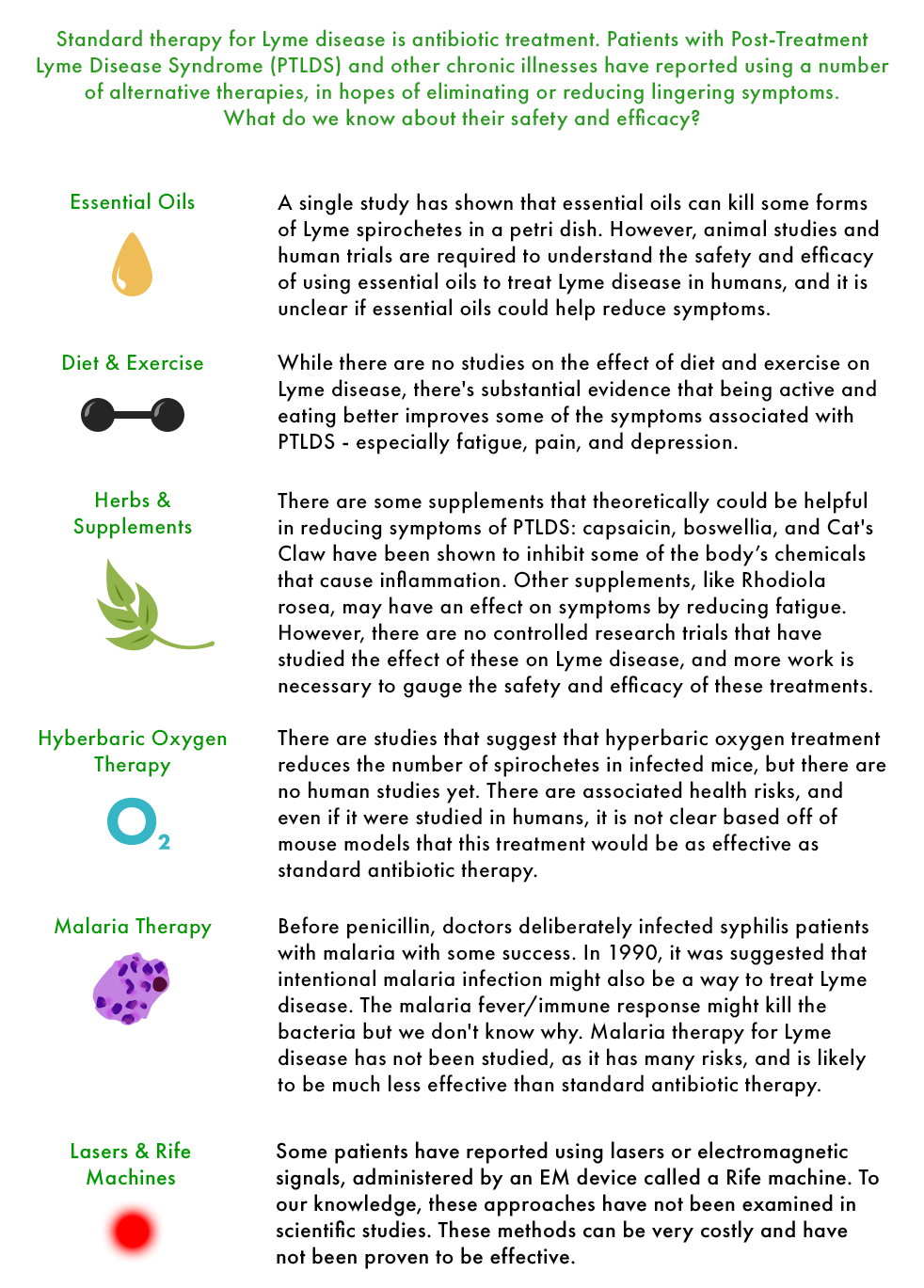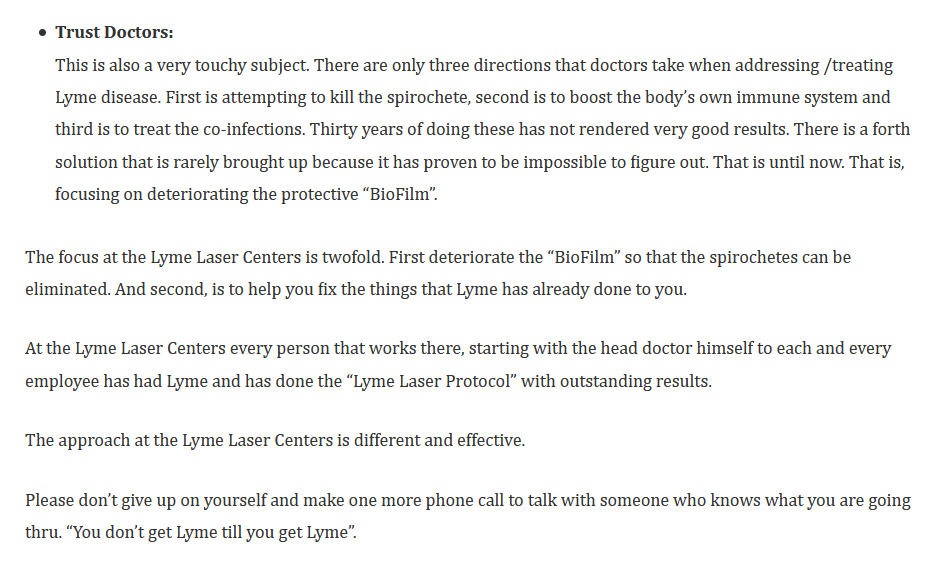Click here for a full transcript
When patients feel like doctors have closed the door to proper healthcare because they’re unable or unwilling to help, another set of doors open. These doors sometimes lead to dubious providers, miracle cures, and untested treatments.
A meeting of a Lyme support group, where patients often discuss their symptoms and treatments (Taylor Quimby, NHPR)
Some Lyme therapies are discouraged or downright condemned by the Centers for Disease Control (CDC). Among these are colloidal silver. It’s a supplement that is literally particles of silver metal suspended in liquid, and while there are no studies to show it does anything helpful for Lyme disease (or anything else) there is evidence that it can screw up your liver. In fact, if you take enough of it, it can turn your skin blue (a condition called argyria). Another questionable treatment is malaria therapy, where people intentionally contract malaria as a way to fight symptoms of Lyme.
Rosemary Jacobs, “The Silver Woman,” whose argyria was caused by childhood use of colloidal silver nasal spray (not for Lyme)
On the other hand, there are things like transcranial magnetic stimulation, which is FDA approved for the treatment of depression, a common diagnosis among people who have suffered with a disease for an extended period of time. This therapy isn’t quackery and doesn’t have many risks associated with it.
And then there are lasers. This type of treatment is more specifically known as Low Level Light Therapy. Patients don’t feel much at all during treatment as the frequencies of the lasers are on the very low end of the spectrum. Low-level light devices are approved by the FDA for the treatment of aches and pains. Studies show that they have some mild effects in reducing inflammation and speeding up the healing process for minor injuries.
So how might lasers cure Lyme disease?
At the Lyme Laser Center in North Andover, Massachusetts, patients go through a treatment protocol involving several different therapies, including lasers. Dr. Doug Wine’s explanation for how lasers can treat Lyme disease rests on something called “biofilm.”
Some pathogens form a protective coating, called a biofilm, under which colonies of bacteria can grow untouched by antibiotics. It’s pretty common in species of bacteria that infect your mouth - dental plaque, for example, is basically a biofilm. One researcher has shown that Lyme bacteria can create biofilms but so far, it’s only been done in lab conditions; biofilms have never been seen in human or animals with Lyme. Dr. Wine says that biofilms explain persistent symptoms in post treatment and chronic Lyme patients, even though the science backing up this claim is flimsy.
Despite the progress of medical science in the last century, there are ways in which the line between healthcare and quackery is still thinner and more permeable than you might realize. Therapies are dismissed because their benefits are hard to measure or aren’t well understood. Conventional FDA approved drugs that perhaps aren’t as effective as we’d perhaps like to believe. But sometimes, there’s a nugget of truth hidden underneath a pile of questionable claims.
Take snake oil. In the mid-19th century, thousands of Chinese laborers came to the United States to build the Central Pacific Railroad across California and Nevada. It was hard work and at the end of a long day, some workers likely used snake oil, a traditional Chinese remedy, for their aches and pains. This oil, which came from Chinese water snakes, was rubbed on the skin topically. The oil was high in Omega 3 fatty acids, which studies have consistently shown can help reduce heart disease and inflammation, that sort that causes arthritis and pain in the joints.
Most of the snake oil that was sold in the 19th and early 20th centuries in the U.S. as a cure all, however, did not come from these special water snakes giving the term a dubious connotation. But the original snake oil, the Chinese remedy, may have had some positive effect.
The temptation is always to say that some therapy is either real evidence-based medicine or pure useless snake oil but sometimes therapies are a little bit of both.
The limits of science...coming up on episode 6.
SCIENCE EXTRA: REFUTING DR. WINE
As of this publication, the website for Lyme Laser Centers includes some dangerous claims, including the statements shown below like “don’t take antibiotics” and “don’t trust doctors.”
But that’s not the extent of inaccurate claims. We took a deeper look at some of the claims Dr. Wine made when we interviewed him.
Statement: “You will have to have [Lyme disease] for a minimum of nine months before you're ever going to test positive.”
It is true that when you are first bitten by a tick, you will test negative on the standard CDC recommended Lyme disease test. One study found that in the first week after a bullseye appears, less than 1 in 5 patients will have enough Lyme antibodies to register. However in the same study, by three weeks after the appearance of a bullseye, that number rises to 85 percent.
This is why the standard practice is to treat anyone presenting a bullseye rash immediately for Lyme disease. Testing is typically most useful for patients who have “disseminated” Lyme disease — usually months after a tick bite, after the bullseye rash and flu-like illness has disappeared and other symptoms begin to manifest. In patients who have cardiac symptoms, acute neurological symptoms, or the classic “Lyme arthritis” the tests have been found to be 85 to 99 percent accurate.
Statement: “70 percent of all ticks carry the Lyme spirochete.”
Charitably we could assume that Doug Wine omitted some words here, and intended to say “all blacklegged/deer ticks.” If that were the case, there is one spot in the country where Lyme infection rates among adult deer ticks approached those numbers: on Shelter Island — the place where the bacterium was first identified — approximately 66 percent carry Lyme. We also have to assume Dr. Wine is rounding up, to make this statement accurate.
Across the whole country, infection rates among blacklegged ticks are closer to 20 percent. Even in the Northeast, where the epidemic is most acute, only around 25 percent of ticks carry the disease. In a recent nationwide study, Connecticut took the top spot at 30 percent.
These numbers are only referring to infection rates in blacklegged ticks, as we start to include dog ticks, western blacklegged ticks, lone-star ticks, and the other ninety tick species found in North America, Doug Wine’s statement becomes even less accurate.
Statement: “The tick is, like, number 7 or 8 down the list of what is actually transmitting disease.”
One study has found Lyme in mosquitoes, deer flies and horse flies. However, the same researchers attempted to transmit the disease from the mosquitoes to hamsters in a lab, and it didn’t work. Dog ticks can also be found to be carrying the Lyme pathogen, but have never been documented as transmitting it.
Enough googling will yield a single “case study” from Finland in which a man believes he contracted Lyme after being bitten by a deer fly, however this single case could also be explained by a tick bite that the jogger never noticed.
Statement: “Now we know that [Lyme disease] is sexually transmitted. We know that it is transmitted by all bodily fluids. You kiss someone, you have sex with someone you're giving it or getting Lyme disease.”
We’ll start with sex, and get to saliva next.
The root of this particular fallacy is a 2014 study that found Lyme disease in vaginal and seminal fluids. Further, syphilis is a spirochete, and is transmitted sexually, so why not Lyme?
The short answer is that detection of a bacteria in a fluid is not the same as proving it has evolved to transmit via that fluid. Syphilis creates open sores or chancres in and around the mouth and sexual organs, which produce large numbers of bacteria in order to facilitate transmission.
A 1991 study on infected rats designed specifically to test this question found no transmission of Lyme occurred through sex. A 1995 study of infected hamsters found the same. To date, there has been no recorded case of Lyme passing from person to person via sex or saliva - though there have been a few documented cases of Lyme being transmitted from mother to child through the placenta.
Statement: “Drink out of one bottle and you forgot which one is yours and you pick up the other one and have a drink of beer, and that guy has Lyme... You just acquired Lyme. One drop of saliva will do it.”
This statement — again — seems to flow from the 2014 study, though we could find no research confirming the presence of borrelia burgdorferi in saliva, only comments from fearful patients at the bottom of blog posts. However, even if it were present — again — this is not enough to ensure transmission.
HIV can be present in saliva as well, but that does not mean that you can get it through kissing.
FURTHER LISTENING/READING
Sawbones podcast on fever, incl. discussion of malaria treatments
“Snake Oil Salesman Were on to Something,” Cynthia Graber, Scientific American
Marketplace of the Marvelous: The Strange Origins of Modern Medicine by Erika Janik
“Colloidal Silver Turns You Blue - But Can it Save Your Life?,” Mallory Pickett, Wired [Spoilers: No.]






